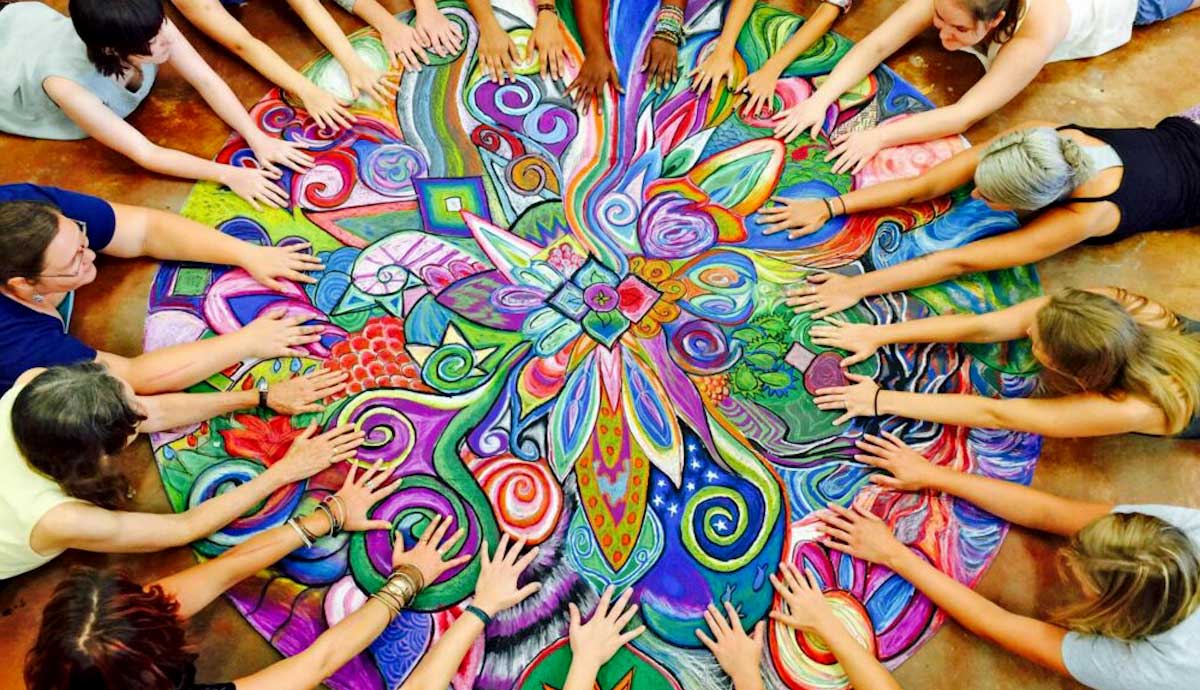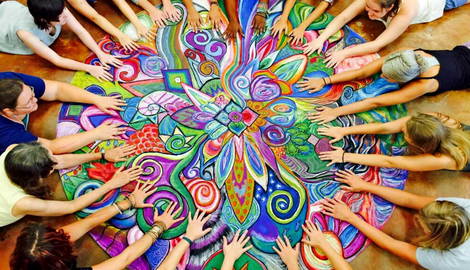
Art was indeed one of the primary sources of communication during the history of humankind. Just remember the cave paintings from the Palaeolithic, from 40 000 – 14 000 years ago. However, art started to be used for its therapeutic features only recently. Art therapy is a new therapy method that uses creative techniques like painting, drawing, coloring, and sculpting to facilitate expression and communication and in this way, help psychological and emotional analysis through art.
History of Art Therapy

Art therapy was developed during the 20th century in Great Britain and the United States of America. The first art therapists in Great Britain were artists without formal education in psychology or psychiatry, who volunteered in hospitals with the idea of helping patients overcome difficulties through art making. Adrian Hill is believed to have been the first one to use the term art therapy in 1942. At that moment, art was used when treating tuberculosis patients. As the patients of this horrible disease had to be locked in sanatoriums, the art process was used to help them engage in artistic activities, express themselves, and combat isolation and loneliness. Soon it was understood that art did help them cope better with their condition.
In 1964 the British Association of Art therapists was founded. In the following decade, the first master’s degree programs focusing on art therapy were organized. Finally, in 1997 art therapy was registered as an official profession in Great Britain.

In 1969 in the United States The American Art Therapy Association was founded. Margaret Naumburg, often said to be the mother of art therapy, was an artist who popularized art therapy in American institutions. Naumburg believed that through art our unconscious and subconscious could be easily expressed, and therefore, could help us cope with our inner problems. Another artist who helped spread art therapy in the United States was Edith Kramer.
Outsider Art

During the 20th century, there was an interest in artwork made by mentally ill patients. Hans Prinzhorn, a German psychiatrist and art historian published his book The Artistry of Mentally Ill in 1922. In this book, he collected over 6000 artworks made by mentally ill patients from European hospitals. Besides showing these paintings and drawings to a greater public for the first time, he also explored the connections between mental illness and creativity. After the book was published, it captured the attention of modern artists, such as Paul Klee, Max Ernst, and Jean Dubuffet.

Jean Dubuffet started collecting artworks he thought were free from societal constraints in 1964. He called these pieces art brut. Today art brut can be found under various synonyms such as outsider art, art extraordinary, or psychotic art. As previously mentioned, outsider art includes artworks made by undereducated people, people who were not trained as artists, who did not have artistic conventions in mind while producing their art, and who were at times diagnosed as mentally ill.
Dubuffet defined outsider art as art that was produced by persons unscathed by artistic culture, where mimicry played little or no part. According to Debuffet: These artists derive everything…from their own depths, and not from the conventions of classical or fashionable art. We are witness here to the completely pure artistic operation, raw, brute, and entirely reinvented in all of its phases solely by means of the artists’ own impulses.
How do we react to images?

David Freedberg and Vittorio Gallese published an article called Motion, emotion and empathy in esthetic experience in 2007. In their research, the scientists explored how people reacted to images. They conclude that after seeing artworks that represent traumatic experiences, such as Goya’s Disasters of War which show terrifying representations of murder and violence during a war, people react to these images as if they lived through them. The authors state that the viewing of images of punctured or damaged body parts activates part of the same network of brain centers that are normally activated by our own sensation of pain, accounting for the feeling of physical sensation and corresponding shock upon observation of pressure or damage to the skin and limbs of others.
Art therapies

We know that art really can help us express ourselves and that the images we see are capable of impacting us greatly, even more so than words. That is why art therapy can help us express our emotions and also better understand them. There are four different branches of art therapy. These include visual arts therapy, music therapy, drama therapy, and dance therapy. In this article, we will focus on visual art therapy which uses visual art techniques such as painting, drawing, or sculpting to help people work through their emotions, experiences, and thoughts.

Our brain processes information in two ways, visually and verbally. As the mother of art therapy, Margaret Naumburg said, thoughts and feelings that come from our unconscious and subconscious mind find their expression easier in painting than in words. That’s why art therapy can help all of us. It is not necessary to be an experienced artist to benefit from art therapy. Similarly, not only people who are diagnosed with mental disorders should try art therapy. This kind of expressive therapy is available to everyone.
When we are kids we doodle and draw all the time. We don’t think about what our drawings look like. We don’t care what someone will think about them, whether they are realistic enough, or if the colors and compositions are correct. We do it because it is our instinct. We continue drawing, painting and doodling until someone tells us that our work is not good enough or that it seems childish.
In art therapy, people create art to explore feelings and emotions, process experiences and understand themselves better. When working with art therapy people don’t paint or draw for their works to be exhibited. Moreover, the artworks created in art therapy are not judged by how they look, but by what they represent. Creating art through therapy often helps the therapists understand the patient’s feelings coming from the unconscious better. Art therapy can also help us deal with stress, anxiety, or low self-esteem. Finally, art therapy is also used with people who suffer from some mental problems, such as depression, dissociative identity disorder, or schizophrenia.

According to the Art Therapy Federation art therapists, the creative process of art making enhances the mind/body connection, fosters personal development, and improves the well-being of individuals. Moreover, art therapists also need to be educated in psychotherapy, which is used along with art therapy. Art therapists often work in private sessions, but also in hospitals, wellness centers, or elderly care centers. The therapies can be done individually, in pairs, or in groups.
Can Art Help Us Heal?

Art can indeed help us heal. Just by itself, the process of artmaking is an enjoyable one. It can help us better understand our feelings, thoughts, and problems that are hard for us to express verbally. It can help us explore our creative side, while the relaxing process of painting, drawing, or coloring can help us cope with everyday stress. It can also serve as an escape from the busy and chaotic lives that most of us are living. Of course, art therapy helps with a wide range of illnesses, such as depression, bipolar disorder, dementia, dissociative identity disorder, and eating disorders. It can also be useful when coping with trauma or loss.

To benefit completely from the process of art making, it is best to attend an art therapy session with a professional art therapist, who has a background both in arts and psychotherapy. However, we can also add creative habits into our daily lives that can help us explore ourselves through different visual mediums. Here are some art therapy exercises that you can try at home. The author Susan I. Buchalter offers different art therapy exercises in her book Art Therapy Techniques and Applications. Here are some examples that you can try out at home.
Best and Worst Self

The materials you will need include: drawing paper, pastels, crayons, and markers. Fold your paper in half and draw yourself at your best on one side and at your worst on the other side of the paper. After you are done, ask yourself the following: Are you presently at your best, worst, or somewhere in the middle? When was the last time you were at your best/worst? This exercise can help us be mindful of our current emotional state.
Stress

The materials you will need include: drawing paper, pastels, crayons, and markers. For this art therapy exercise, you can draw things that cause you stress. You can include people, places, and other emotional stressors from your life. After drawing, analyze what you drew. What are the sizes and shapes of your stressors? The artwork allows you to measure your stressors in terms of significance by observing these factors. The goal of this exercise is for you to examine challenges and explore coping mechanisms.
Counting Blessings

The materials you will need include drawing paper, pastels, crayons, and markers. In this exercise think about positive things in your life and draw them in any manner you please. See how often you focus on the pleasures in life instead of problems and frustrations. Emphasizing one’s blessings can help one cope with depression, problems, and concerns. Refer back to the artwork you have done whenever you need extra support or comfort. This exercise can help us increase our self-esteem and self-awareness.










